Super Glues are one of those things that seem like they’re probably all the same. Yet when you dig deeper, you quickly realise there’s a lot of differences between them, meaning that there’s a few things that need to be considered when it comes time to pick the right one for your application. This is true regardless of whether you're looking for a glue for model making, craft, maintenance or a specialised industrial strength super glue.
To help you choose the best glue for your job, we’ve put together this comprehensive guide to industrial strength super glues. It’s not going to consider absolutely every possible material combination or bonding factor, but we will try and cover as much as possible.
For those of you looking for a short-cut without the reading, we really do recommend the Weicon Adhesive Finder and Mobile Apps. They both let you input the type of materials you need to bond, select a few extra requirements (like temperature, gap and desired strength) and then they provide you with a list of suggested adhesives. Best of all, the Android, IOS and web based adhesive finder tools are all completely free to download and/or use.
For those of you looking for more information on why these tools produce the results they do, please do read on and please don’t hesitate to add any questions or comments you have at the bottom. We’re always looking to improve our guides and your feedback is crucial in helping us do so.
Sections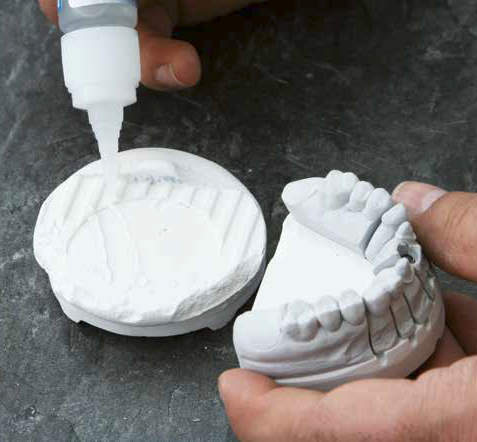
- What Are Super Glues?
- Where are super glues used?
- Why are there so many different types of super glue?
- How do I choose the right super glue for my application?
- Tips for using super glues.
What are Super Glues?
Super Glues are a specific type of adhesive also known as cyanoacrylate adhesives. They bond by reacting with the moisture in the air and on the surfaces of the materials they are bonding. Many different grades of glue meet this definition but there are some important differences between them as we’ll discuss later. That being said, they do share some common characteristics which can best be explained by looking at their strengths and weaknesses.
What Are Super Glues Good At?
- Fast Bonding
One distinguishing feature of super glues is the speed with which they bond. Typically, this can be measured in seconds. You will see differences between grades and can even expect to see differences in performance, depending on the environment and materials you’re working with. Generally, the warmer the environment and the higher the humidity, the faster the bond. - High Strength Bonds
Another feature of super glues is the strength of the bonds they form. Again, this is a pretty general statement and there will be differences depending on the grade, materials, environment and so forth. Compared to other types of adhesives though (e.g. silicones, MS polymers) super glues are incredibly strong. For instance, when bonding Nitrile Butadiene Rubber (NBR), our VA 8406 achieves a shear strength of greater than 8 N/mm². If you’re wondering why we have to say greater than, it’s because at this point the bond is stronger than the rubber. Put another way, the rubber breaks before the adhesive join does. - Material Compatibility
Generally speaking, super glues are pretty versatile and will work with most types of materials. Most will bond common metals, wood, ceramics, glass and so forth as well as certain kinds of rubber and plastics. There are exceptions and this is one of the major points of difference between the grades and consequently, one of the first things you should look for when choosing a glue; will it work with the materials you need to bond? - Economy
Super Glues are very economical to use. Admittedly, they can seem a little expensive when you compare them to a generic adhesive but it’s the amount you can do with each tube that matters. As a good rule of thumb, one drop of super glue is enough to cover an area about 25mm². In fact, one of the worst mistakes you can make with super glue is to use too much. This slows down curing and can, in certain circumstances, even reduce final bond strength. With super glues, less is more, meaning that a single pen is often enough to bond quite a large number of objects. - Simplicity – No Mixing
Super Glues are one part adhesives which means there’s no mixing involved. This can be a real benefit as some other glues require precise combinations of different parts to work. The only time you’re looking at anything like mixing with a super glue is if you are using a primer, filler or activator but even then the process is, in our opinion, a lot simpler than combining precise weights or volumes, stirring and then applying.

What Can Super Glues Struggle With?
- Larger Surface Areas
Usually, super glues are used for bonding smaller surface areas or objects such as attaching a strip to a door frame, joining an O ring cord or fixing a broken part on an ornament. Because of the speed they cure and the fact they’re not really designed for bridging larger gaps, you usually wouldn’t use them for bonding something like a metre square sheet of rubber onto the tray of a utility vehicle. - Low Surface Energy Materials
Low Surface Energy materials are notoriously difficult to bond. Generally, Super Glues (and pretty much every other type of glue, adhesive tape or sealant) bond by “wetting” the surfaces they stick to. Low surface energy materials resist this wetting and therefore resist bonding. This makes them very hard to bond to with any adhesive (not just super glues).
Examples of low surface energy include PTFE (commonly known as Teflon), polyethylene and polypropylene. If you’re working with a low surface energy material, you really need to carefully select an adhesive that will work with it. It is possible to still bond to these materials but you may need to consider using a primer on them first. Weicon Contact Adhesive Primer, combined with our VA 8406 Super Glue will enable bonding to pretty much all low surface energy materials. We’ve even tested and found it works with bonding Teflon. - Temperature
Good temperature resistance is a pretty general term I suppose, so I may be a little harsh when I say that super glues can struggle with high temperatures. They’re not going to fail on a hot summer's day, but you will find that many super glues are rated “only” up to about 80°C. Like all things though, there are exceptions. If you need something with a little more temperature resistance, we suggest looking at our Weicon VA 30 Black Super Glue which will handle continual exposure up to 140°C. - Accuracy
As a consequence of the speed at which they cure and the fact they’ll bond to most things (including skin), you need to be pretty accurate when applying super glues. To assist with this, the vast majority of our Weicon Super Glues come in specially designed pens rather than bottles. I’ll let the owner of Weicon, Ralph Weidling, explain why…
“I was watching my daughters using crayons at home. Then I thought, this is what we need for our one part adhesives! A packaging style that makes dosing and clean application easy and simple.” A short time later the plans were drawn up and the special pen design used today was born. - Blooming
Blooming is a consequence of the cure method that causes the glue to take on a white-ish colour. Some types of super glues are more prone to this than others. If your application really demands a super glue that’s particularly clear after cure, then I suggest looking into those manufactured using an alkoxy ester such as Weicon VA 1408, VA 1460 and VA 1403 (these aren’t currently stocked by Swift Supplies but can be arranged by special order). - Joint Movement
Generally, super glues cure to form a fairly rigid bond that resists movement in the joint. Once again, I should stress that this is a general statement and there are definitely exceptions to the rule. While no super glues approach the elasticity and elongation capacity of something like silicone or an MS polymer, grades like our Weicon VA 30 Black which is a special rubber filled super glue have increased residual elasticity which makes it a good option when you need to allow for a little movement in the bonded parts after curing. This often happens in areas with highly variable temperatures or high humidity. - Fumes While Curing
Most super glues will emit some smell while they’re curing. Every single one of our super glues has a SDS (Safety Data Sheet) attached to its product page which details proper safety precautions and we really do suggest you familiarise yourself with these documents before use. One thing the SDS doesn't cover though is the effect these fumes (and the cure process itself) can have on sensitive plastics, particularly clear ones like those used for windscreens on model trains or cars (hint, they can make them go a little cloudy). Once again, an alkoxy ester type may be the solution as these tend to emit less fumes (and are less prone to blooming). VA 1408, VA 1460 and VA 1403 all match this requirement.
Where are super glues used?
This section will be a little shorter than the last as this is far easier to answer. Super glues are used pretty much everywhere. You’ll find them being used in applications as diverse as fixing broken ornaments to model making, electronics manufacturing and even high pressure seal repair.
I honestly couldn’t list all the applications we’ve seen even if I tried. Anyway, it’d be a pretty boring list so instead here’s a few application photos we’ve been lucky enough to have shared with us to spark your imagination.
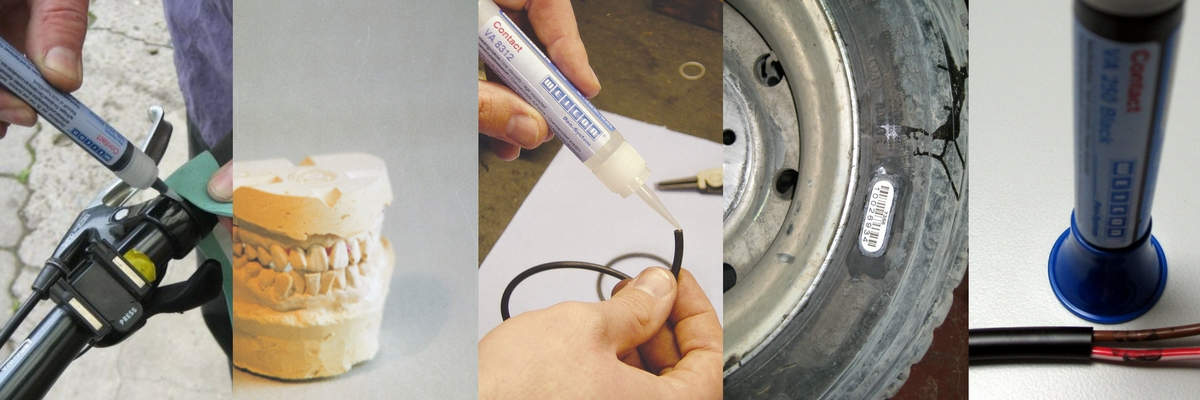
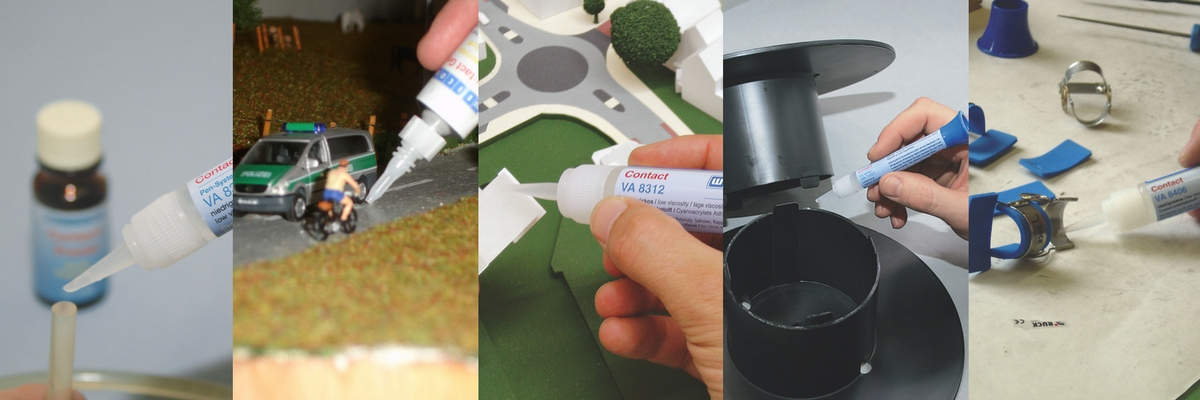
Why are there so many different types of super glue?
Generally speaking, each type in the enormous range of super glues in existence has been developed to work in specific conditions. Given the wide range of areas they can be used in, this has led to a huge range of glues. The list of things that could potentially differentiate one from the other is almost endless, especially if you start to include things like pack size, rarity, price, storage life and so forth. Rather than list everything, below I’ll list a few of the main points of technical difference that you’ll often find between various grades of super glue:
- Ester Type
Typically, either Ethyl, Alkoxy or Methyl. Of these, Ethyl Ester is the most common and glues based on this type of ester are among the most versatile, general-purpose super glues. Alkoxy ester based cyanoacrylates are often less prone to blooming and generally emit less odour during cure. Methyl ester based glues are particularly compatible with metals. - Viscosity
A technical term for the thickness of a substance. The higher the viscosity, the thicker the liquid (so custard would have a higher viscosity than milk). Viscosity is a major point of difference among grades of super glue and the desirability of a higher or lower viscosity will depend on your application. A general rule of thumb (that is not applicable to all grades) the higher the viscosity the slower the cure time. That said, higher viscosity glues can be a little easier to apply to complex or vertically-aligned surfaces as they’re less prone to running. - Material Compatibility
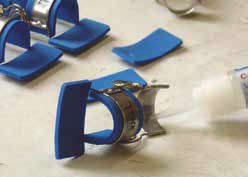
Not all super glues work equally well with every type of material. This can be due to several factors including their basis, viscosity and more. The difference in potential achieved bond strength means that picking a glue that is compatible with what you need to bond is likely one of the first things you should consider. - Bond Strength
Different types of super glues will achieve different degrees of bond strength. All will create strong bonds in a very general sense but there are definite differences in actual strength. For instance, VA 8312 has a shear strength rating of 20 N/mm² on sand blasted steel while VA 30’s is 22 N/mm². On ABS plastic however, it’s VA 8312 that comes out on top with a rating of 12 N/mm² to VA 30’s 11 N/mm². - Cure Time
You can expect to see large differences in estimated cure times for different grades of glue. All will be impacted by the materials you’re bonding, the environment you’re bonding in and other things like the amount of glue you use. Typically, you’ll find that thicker grades have a longer cure time while runnier (low viscosity) grades are faster. All super glues are fairly quick though and most will be fully cured in 24 hours while achieving a fairly strong bond well under 10 minutes. - Gap Coverage
Different grades of cyanoacrylates will be able to cover different size gaps between the materials being bonded. As mentioned earlier, none of these will be super large. To illustrate, VA 8406 has a maximum gap coverage rating of 0.1mm while VA 30 Black has a maximum rating of 0.2mm. I’ll be the first to admit that 0.1mm isn’t exactly large but it is a 100% difference and can be a critical factor for some uses. - Temperature Resistance
No explanation necessary here. Different grades will withstand different amounts of temperature. Just a quick word of warning, some brand's descriptions and even their technical data sheets will refer to a glues short-term maximum as their maximum operating temperature. We'll never do that. We'll either list both clearly marked or just the temperature rating the product is able to withstand on an ongoing basis. - Colour
The vast majority of super glues will be colourless, clear liquids. There are exceptions though like our VA 30 Black which has a rubber filler and is, you guessed it, black. It should also be noted that blooming can have an effect on the clarity of a glue when cured. Once again, Alkoxy Ethyl based super glues are usually the best choice for those of you who require low-blooming super glues. - Dielectric Strength
Most types of super glue do not conduct electricity though there could well be exceptions to this in the market that I’m not familiar with. One thing I do know for sure is that the insulation strength (dielectric strength) does differ between grades; though not within types in the Weicon range. All these have a dielectric strength of 25kV/mm. - Approvals and Certifications
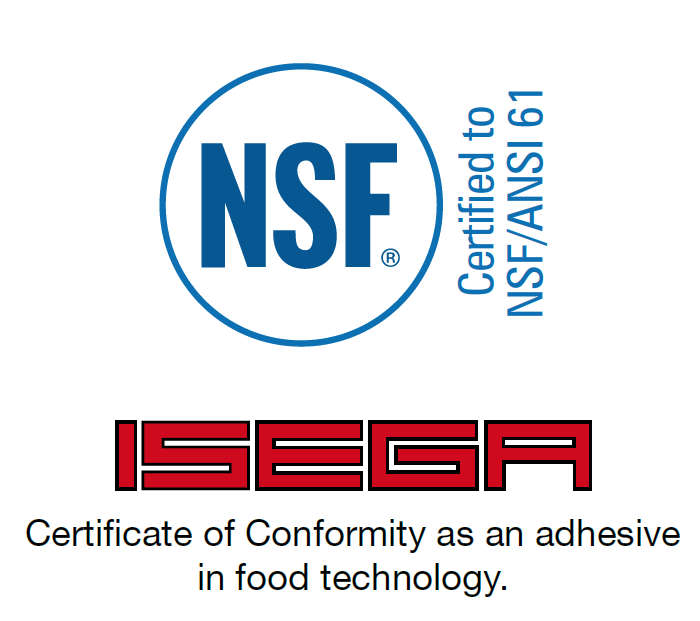
For highly critical or particularly demanding applications, you may require a super glue with specific approvals. Different grades are often available for such things as potable water compatibility, food grade applications and more. This can be a major point of difference between grades, brands and types. - Special Features
In addition to all the points of difference listed above, there are many, many more things that differentiate one super glue from another. Shelf life, specific gravity, flash point, thermal conductivity, solubility, thermal expansion rate, squatting temperature and more can all vary.
Even though specific requirements in these areas don’t come up to often, we provide specifics for all of these (and more) on each of our Weicon Super Glue Technical Data Sheets which are available on the product page (media tab) for each grade. If you do need information that isn’t listed, don’t hesitate to let us know as we’ll be more than happy to investigate and report back for you.
How do I choose the right super glue for my application?
I hate to be the one to tell you, but there’s no fool-proof method. Basically, it’s a situation where you need to look at the list of things that typically differentiate types of super glue, identify those that are most important for your particular application and then make your selection using these.
I am happy to say there are some things that can help you do this though. Weicon, our favourite super glue manufacturer, have been good enough to put together a fantastic tool called the Adhesive Finder. You can check it out here: (www.adhesive-finder.com). The Adhesive Finder is also incorporated it into their excellent Weicon Mobile App (available free for Android and IOS) which also includes all their TDS, SDS and even some product videos!
To give you an idea of how the Adhesive Finder works and if I was looking for a glue to bond some of our Neoprene Strip to Galvanised Steel I’d input the following into the Adhesive Finder:
- Material: Metal Active (Steel, Copper, Brass, Bronze)
- Connect To: Rubber
- Bonding Method: Overlapping (Used to specify small bonding area)
- Bonding Gap: <0.2mm
- Handling Strength: Less Than 1 Minute (I’m impatient)
- Strength: All
- Temperature: All
- Further Requirements: None
Here’s what I’d get…
That narrows it down a bit. Obviously, then I would go and search Swift Supplies to find which one of those that rated as 100% is available in the size I want.
Super Gluing Plastic
One of the most common applications for super glues is to bond, fix, or repair different types of plastic. Depending on the exact grade of plastic and glue, this can either be very easy or quite tricky. To help with this, we've put together a 4 part blog series on our best super glues for plastic. It covers everything inlcuding how to identify what kind of plastic you have, glue selection, surface preparation and tips for applying the glue to acieve maximum bond strength (many of which are listed below as well). You can reach each section in the series via the following links:
Part 1: Tips and Methods for Identifying Different Types of Plastic
Part 2: Choosing a Super Glue for Different Types of Plastic
Part 3: Preparing the Plastic Surface for Bonding
Part 4: Applying the Glue and Tips for Maximum Bond Strength
Tips for using super glues.
I hate to be boring but most of these tips are really going to be variations on the theme “follow the instructions”. Trust me, I’ve done it both ways and it turns out that following the instructions really does make a difference.
Before I move on to summarise some of what I consider the more important tips for using super glues, I would like to mention that to make following the instructions easy, they are included on each and every bottle of all of our Weicon Super Glues. It might not look like it from the photos but the label actually unwinds to reveal full instructions and don’t worry, they’re in English (as well as German). Also, most of the glues listed on our site have demonstration videos included (on the media tab). Super convenient for getting an idea of what a grade is capable of and how to use it.
- Surface Preparation
Firstly, if you’re working with really smooth surfaces (like one of our sheets of plastic shim) it will be worth your while roughening it a little. A light sanding will do the trick. This significantly increases the available surface area for the adhesive to bond to and will significantly improve adhesion.
Regardless, make sure that both surfaces being bonded are completely clean and dry. Super Glues will stick to anything, including dirt or dust and every bit of dust they stick to reduces the amount of surface they bond with. - Gloves
Speaking of super glues bonding to everything, this includes skin. The SDS for each grade in our Weicon range details precise actions to follow if the glue does come into contact with your skin so I won’t repeat them here. What I will say is the extra few moments to put on a pair of gloves is totally worth it. I’ve skipped this step and regretted it. - Masking
If the area you’re bonding is particularly complex, it will make life a lot easier if you mask the surfaces surrounding the bonding area before applying the glue. Mistakes do happen and a bit of masking tape can stop them from being too problematic.
While on the subject of masking, it’s also a good idea to cover up surrounding areas with an old rag or cloth. Just in case you drop the bottle this will prevent surfaces being ruined. - Bottle Shape
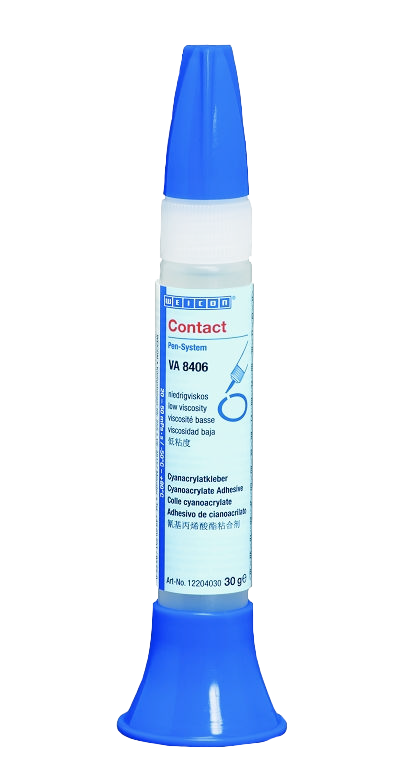
Turns out, bottle shape does matter. Maybe not so much if you’re sticking larger surfaces but when you’re working with really small objects that need a precise fit, having the right size and shaped bottle can really make things easier. The vast majority of our Weicon Contact Adhesives are available in their special, pen-shaped bottles for just this reason as this shape allows your muscles to work the same way they would with a pen. That said, sometimes a small squeeze tube may be better and for that reason our VA 100 and Contact Gel are both available in other options. - Storage
Chances are, if you follow the super glue mantra that “less is more” (you should), you won’t use the whole pen at once. That’s fine. To get the longest possible shelf life out of your cyanoacrylate, clean up any excess adhesive around the opening, squeeze any excess air out of the tube and ensure the lid is placed back on tightly. Remember, super glues work by reacting with moisture in the air so ensuring that the lid is air-tight is critical. Once you’ve done this, we suggest storing the tube in a cool, dry and dark place out of direct sunlight. Personally, I keep open containers in the fridge because I’m from Queensland where there’s no such thing as a cool place year-round. This will extend the usable life further if you can do it. - Clean Up
If you do need to remove cured super glue from a surface, you’ve really got two options; mechanical or chemical removal. Mechanical involves scraping or grinding (depending on the size/type of surface) while chemical involves the use of solvents. Solubility for our Weicon Super Glues are listed on each grades technical data sheet.
That's about it for now. We'll be sure to keep updating this page as we come across extra information, resources and tips.If you spot something you think we missed or have a great tip that could help others get the most out of their super glues, be sure to let us know in the comments.

.JPG)